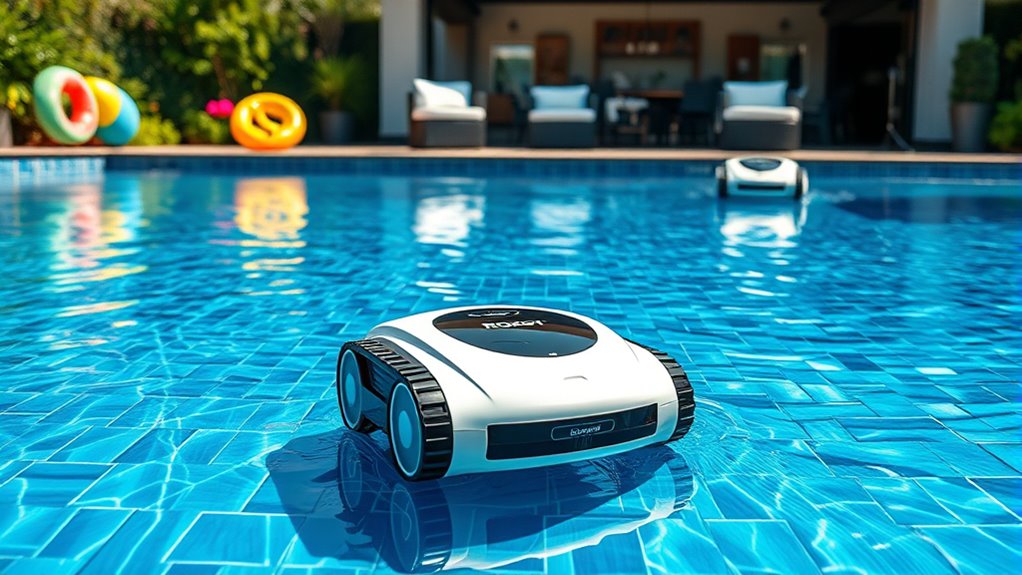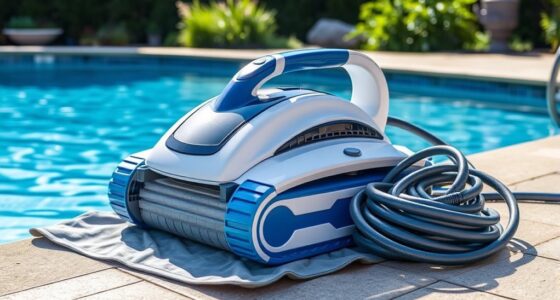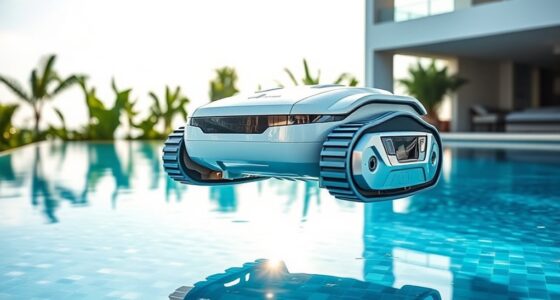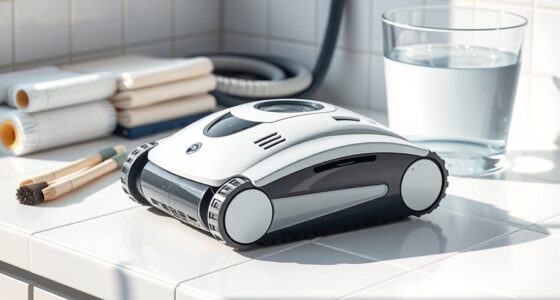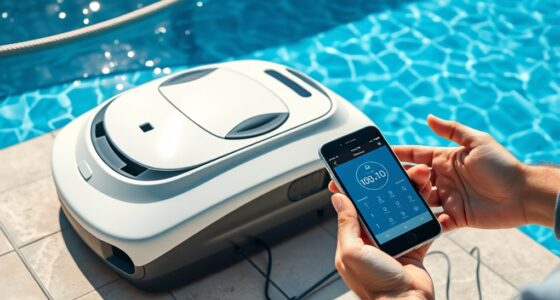Robotic pool cleaners designed for above-ground pools are generally smaller, lightweight, and offer shorter battery life, making them ideal for easy handling and quick cleaning. In-ground pool models tend to be larger, with better filtration, longer runtimes, and advanced navigation features to handle bigger surfaces and complex shapes. Each type depends on size, features, and environment, so choosing the right one can improve your cleaning results. Keep exploring to discover the best options for your pool.
Key Takeaways
- In-ground pool cleaners typically have longer battery life and more powerful suction than above-ground models.
- Above-ground pool cleaners are often smaller, lightweight, and easier to handle for quick setups and maintenance.
- In-ground pool robots usually cover larger areas more efficiently with advanced navigation systems.
- Above-ground pool cleaners may have higher noise levels and shorter cleaning cycles due to size constraints.
- Compatibility depends on pool size, shape, and debris load; select models designed specifically for your pool type.
Differences in Design and Size
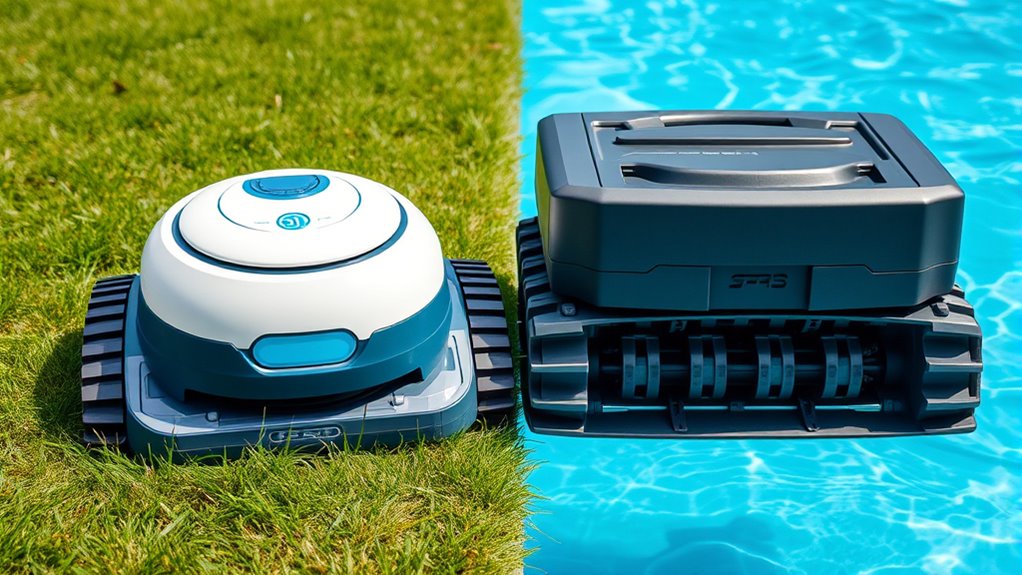
Have you ever wondered how robotic pool cleaners vary in their design and size? These differences profoundly impact your cleaning experience. Design aesthetics matter because some models feature sleek, compact shapes that easily navigate tight spaces, while others are bulkier with more prominent features. Additionally, the material durability is vital; high-quality plastics and corrosion-resistant components ensure the cleaner withstands pool chemicals and constant water exposure. The size of the cleaner influences maneuverability and suitability for your pool type. Smaller models might be lightweight and easier to handle, but larger units often include more advanced features. Moreover, size considerations play a crucial role in determining how well the cleaner can cover your entire pool efficiently. Considering product specifications can help you select a model that best fits your pool’s unique requirements. Furthermore, design innovation continues to improve the efficiency and user-friendliness of robotic pool cleaners, making the selection process more tailored to individual needs. Additionally, technology integration such as smart navigation systems enhances cleaning precision and reduces manual oversight.
Cleaning Capabilities and Features

Robotic pool cleaners come equipped with a variety of features designed to optimize their cleaning performance. These include smart navigation, which enables them to efficiently cover the entire pool surface, and advanced filtration systems that capture debris, dirt, and algae. Some models use sensors to detect obstacles and adjust their path, ensuring thorough cleaning without getting stuck. Filtration systems vary from basic filters to multi-stage setups that improve water quality. Many models also incorporate vacuum technology to enhance debris removal and efficiency. Additionally, incorporating smart home integration can allow users to control and monitor cleaning cycles remotely for added convenience. Proper filtration and pump protection is essential to maintain optimal performance and extend the lifespan of the cleaner. Regular system checks and maintenance procedures help prevent malfunctions and ensure consistent operation.
Compatibility With Pool Types and Sizes
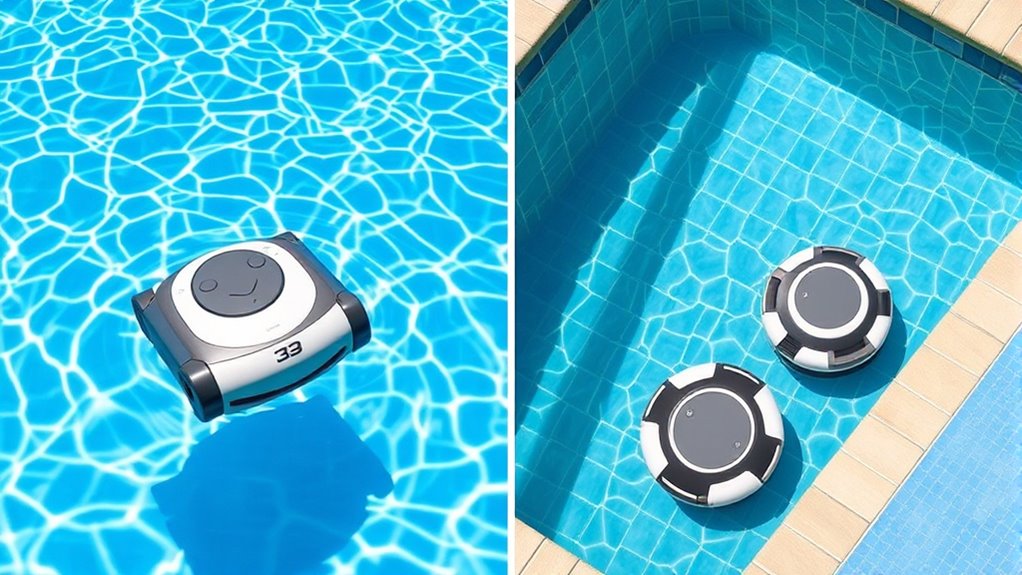
Not all robotic pool cleaners work well with every pool size or type, so you’ll need to verify compatibility before buying. Larger pools may require more powerful models, while small or above-ground pools can have limitations. Understanding these factors ensures you choose a cleaner that fits your pool perfectly. Additionally, top-rated options often feature adjustable settings to accommodate various pool shapes and depths.
Pool Size Compatibility
Are you unsure if a robotic pool cleaner can handle your pool’s size? If so, consider these key points:
- The cleaner’s recommended pool surface area guarantees it can cover your entire pool efficiently. Additionally, understanding the technology features of the device can help determine if it meets your specific needs. Knowing the size restrictions for different pool types ensures compatibility and optimal performance. Pay attention to how design elements influence the cleaner’s effectiveness across various pool configurations.
- Larger pools demand models with faster cleaning speeds to reduce cleaning time.
- In-ground pools typically require units with higher suction power and longer runtime for thorough coverage.
- Some models are specifically designed to optimize performance kits and enhance overall cleaning efficiency for different pool types.
Always check the manufacturer’s specifications to confirm the cleaner’s capacity for your pool size. Smaller models work well for above-ground pools, but bigger in-ground pools may need a more robust device. Matching your pool’s size guarantees thorough cleaning without overtaxing the cleaner, providing excellent performance and efficiency.
Above-Ground Limitations
While robotic pool cleaners are great for maintaining pools, their compatibility with above-ground pools has some limitations. Historically, trends favored in-ground models, but recent technological innovations have improved above-ground compatibility. However, not all cleaners fit every pool size or shape. For example, larger pools may require more robust models, while smaller pools might not be suitable for some units. Additionally, considering best small wood stoves can be useful when planning outdoor heating solutions to complement poolside activities. Properly matching the pool type and size with the right robotic cleaner ensures optimal performance and longevity. Being aware of pool shape and features can also impact the effectiveness of certain models, making it essential to choose a compatible and adaptable device.
Installation and Maintenance Requirements
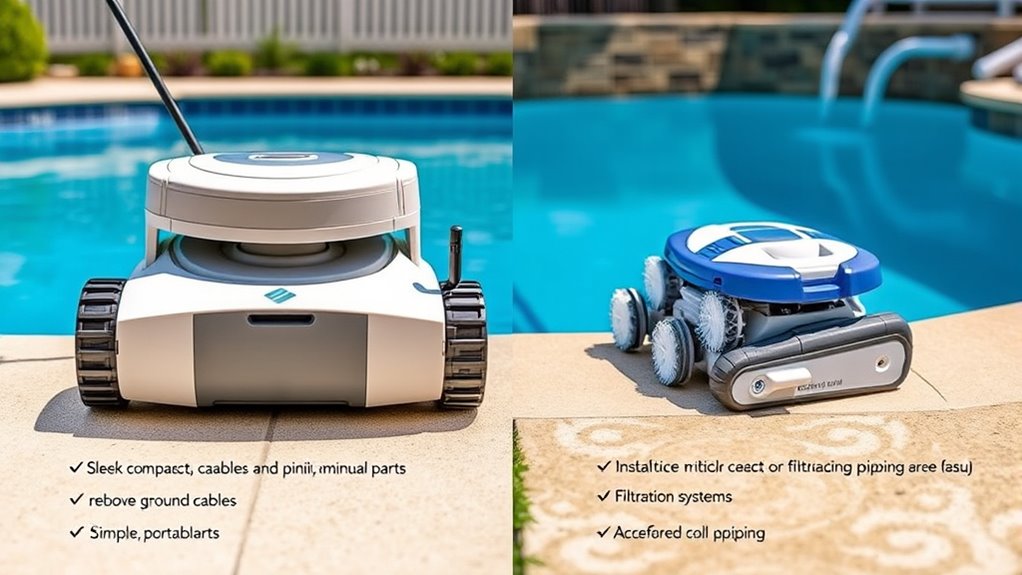
Proper installation and regular maintenance are essential to guarantee your robotic pool cleaner operates efficiently and lasts longer. To maximize performance, consider these key factors:
- Battery life – Ensure the battery is fully charged and replace it when performance drops. Regularly monitoring battery health can prevent unexpected failures and extend the overall lifespan of the device battery management.
- Power consumption – Choose models with energy-efficient motors to reduce electricity bills and promote sustainable operation.
- Cleaning and checks – Regularly clean the filters and inspect for debris or damage to prevent malfunctions.
- Scalp health – Regular maintenance of the cleaner’s brushes and seals can help maintain optimal scalp health, ensuring consistent cleaning efficiency and prolonging the device’s lifespan. Incorporating preventative maintenance routines can also help identify potential issues early, reducing costly repairs and downtime. Additionally, understanding the wireless connectivity features of your cleaner can facilitate easier troubleshooting and updates.
Cost Considerations and Budgeting
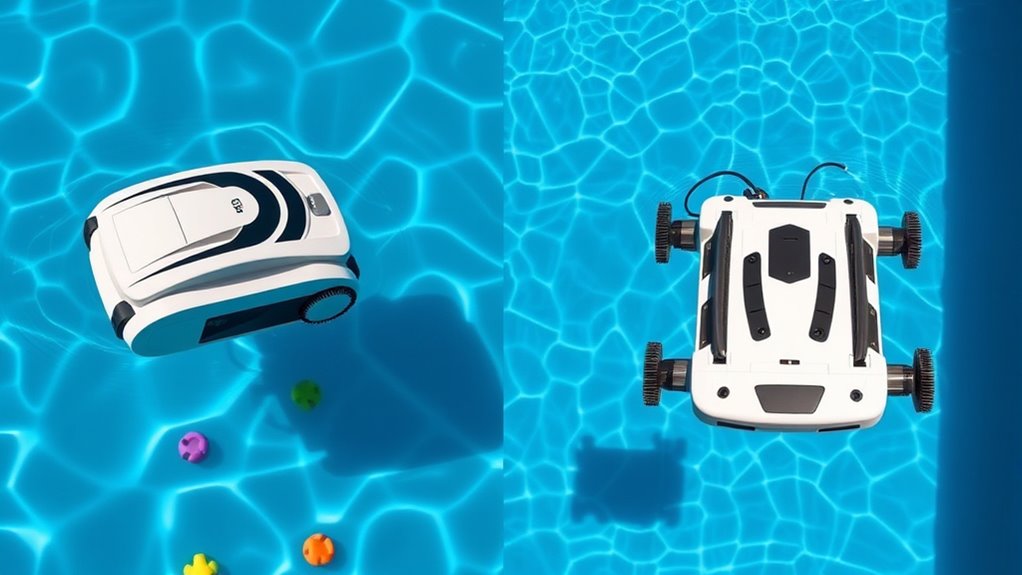
When considering robotic pool cleaners, you’ll notice price differences that can impact your budget. Keep in mind that maintenance expenses can add up over time, affecting overall costs. However, investing wisely can lead to long-term savings through reduced manual cleaning and fewer repairs. Incorporating features like effective wall cleaning can enhance the value and efficiency of your robotic pool cleaner. Additionally, understanding symptoms of breast cancer can help ensure prompt detection and treatment if needed, emphasizing the importance of awareness and regular maintenance. Monitoring website performance metrics can also help you optimize your pool care routine and ensure your cleaner is functioning effectively. Furthermore, applying performance tuning principles from the automotive industry can inspire innovative ways to enhance your pool cleaner’s efficiency and longevity. Recognizing the influence of art and cultural significance can inspire design choices that make your pool area more aesthetically pleasing and engaging.
Purchase Price Differences
Robotic pool cleaners come in a wide range of prices, making it essential to contemplate your budget before making a purchase. Higher-priced models often feature better brand reputation, more reliable warranty coverage, and advanced cleaning capabilities. To help you decide, consider these factors:
- Initial purchase cost varies markedly between models designed for above-ground and in-ground pools.
- Premium models with strong brand reputation tend to have higher prices but offer longer-lasting performance.
- Warranty coverage can influence long-term savings, protecting you from unexpected repair expenses.
Balancing cost with quality ensures you get a reliable cleaner suited to your pool type without overspending. Remember, investing in a reputable brand with good warranty coverage can save you money and hassle in the long run.
Maintenance Expenses Impact
Maintenance expenses can substantially impact your overall budget for robotic pool cleaners, as ongoing costs often surpass the initial purchase price. Energy consumption plays a significant role, especially if the robot runs frequently or has high power demands, increasing your electricity bills. Additionally, warranty coverage is vital; a good warranty can help reduce repair costs and extend the cleaner’s lifespan. Keep in mind that some models may require regular part replacements or professional servicing, which adds to your expenses over time. To manage costs effectively, consider energy-efficient models with extensive warranties. Regular upkeep can also prevent costly repairs, ensuring your investment remains economical in the long run. Budgeting for these ongoing expenses helps you make an informed decision and avoid surprises down the line.
Long-term Cost Savings
Long-term cost savings with robotic pool cleaners depend on careful planning and budgeting. To maximize savings, consider these factors:
- Battery longevity – higher-quality batteries last longer, reducing replacement costs over time.
- Warranty coverage – a strong warranty can protect you from costly repairs and replacements.
- Maintenance costs – choosing models with durable parts and good warranty support minimizes ongoing expenses.
Investing in a model with extended battery life and extensive warranty coverage might have a higher upfront cost but pays off through reduced maintenance and replacement needs. Proper budgeting ensures you select a cleaner that offers long-term savings while keeping your pool pristine without breaking the bank.
Performance and Efficiency in Different Environments
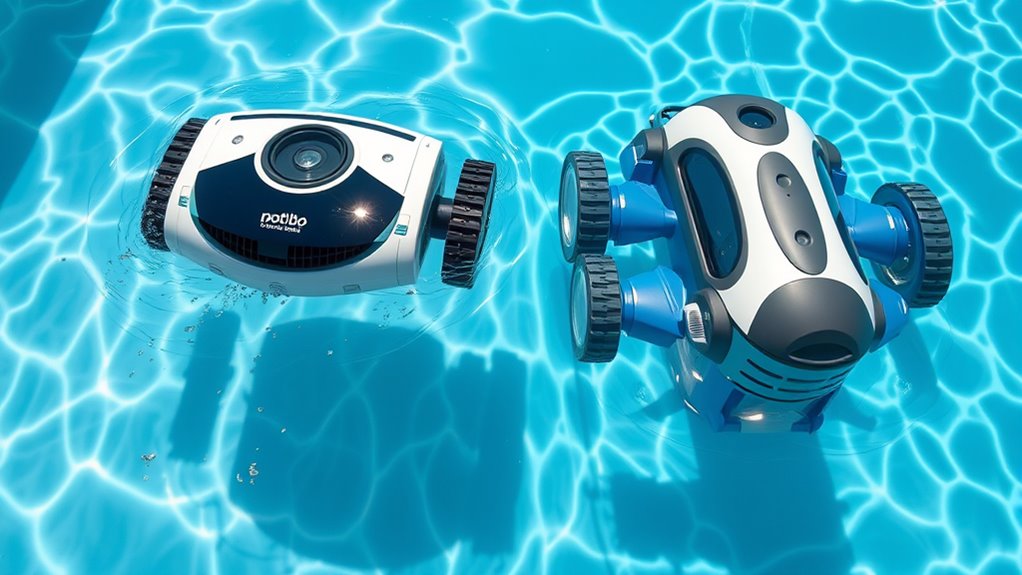
While robotic pool cleaners are designed to adapt to various environments, their performance can vary markedly depending on your pool’s conditions. For above-ground pools, they often have shorter battery life due to larger cleaning areas, and noise levels tend to be higher because of less insulation. In contrast, in-ground pools usually benefit from longer battery life and quieter operation thanks to better insulation and more efficient motors. Factors like debris type, pool shape, and surface material also affect cleaning efficiency. Here’s a quick comparison:
| Environment | Battery Life | Noise Levels | Key Considerations |
|---|---|---|---|
| Above-Ground Pools | Shorter (approx. 1-2 hrs) | Higher due to less insulation | Larger surface, quick recharge needed |
| In-Ground Pools | Longer (up to 3-4 hrs) | Quieter, more insulated | Better suited for extended cleaning |
| Both | Varies with model | Generally adjustable | Choose based on pool size and environment |
Frequently Asked Questions
Can Robotic Pool Cleaners Be Used for Saltwater Pools?
Yes, robotic pool cleaners can be used for saltwater pools. Look for models with saltwater compatibility and corrosion resistance, as these features guarantee durability in a salty environment. Saltwater can be tough on electronics and materials, so choosing a cleaner designed for these conditions helps prevent damage. Always check the manufacturer’s specifications to confirm it’s suitable for saltwater pools, guaranteeing efficient cleaning without risking corrosion.
How Long Do Robotic Cleaners Typically Last Before Replacement?
On average, robotic pool cleaners last about 5 to 7 years before needing replacement. Proper maintenance schedules, like regular filter cleaning, can extend their lifespan. They’re designed to be energy-efficient, consuming less power over time. You might notice decreased performance or more frequent breakdowns as they age, signaling it’s time for a replacement. Staying on top of upkeep helps you get the most out of your robotic cleaner.
Are There Eco-Friendly Robotic Pool Cleaners Available?
You’ll find eco-friendly robotic pool cleaners on the market, often powered by solar power, which reduces energy consumption. Some models incorporate biodegradable materials, making them more sustainable and environmentally conscious. These cleaners help you enjoy a clean pool while minimizing your carbon footprint. Look for options that emphasize renewable energy sources and eco-friendly construction to guarantee you’re choosing a greener solution for your pool maintenance needs.
Do Robotic Pool Cleaners Require Wi-Fi or App Connectivity?
Coincidentally, many robotic pool cleaners now come with Wi-Fi connectivity and app control, making your cleaning routine smarter and more convenient. You can schedule, monitor, and even troubleshoot your cleaner right from your smartphone. While not all models offer these features, choosing one with app control guarantees seamless operation. So, if you want effortless pool maintenance, look for a robotic cleaner with Wi-Fi and app connectivity for ultimate convenience.
What Safety Features Are Included in Robotic Pool Cleaners?
You should know that robotic pool cleaners include essential safety features to guarantee pool safety and cleaning safety. Many models have automatic shut-off when lifted, preventing accidents. Some come with safety sensors to avoid obstacles and prevent damage. These features help protect you and your pool equipment, making your cleaning routine safer and more reliable. Always check the specific safety features of your robotic cleaner to maximize safety during use.
Conclusion
Choosing the right robotic pool cleaner depends on your pool type, size, and budget. Did you know that above-ground pool cleaners are typically 30% cheaper but may have fewer features than in-ground models? By understanding their differences, you can find a device that saves you time and keeps your pool sparkling. Invest wisely, and you’ll enjoy a cleaner pool with less effort—making pool maintenance a breeze all season long.
